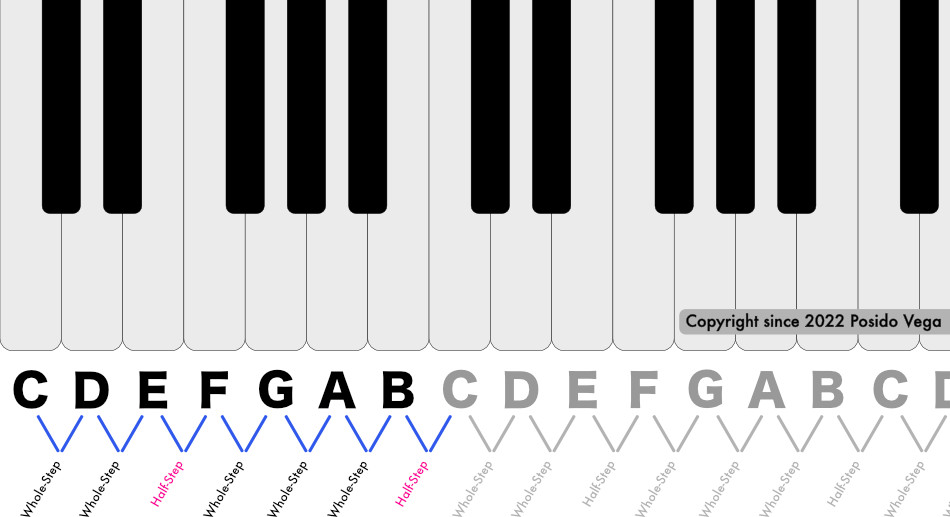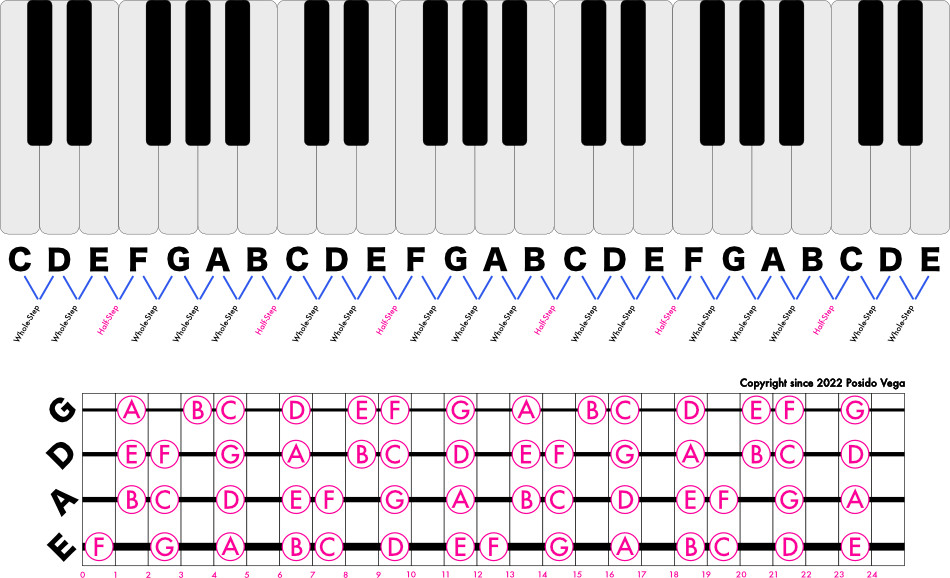Learning the notes on your 5 string bass guitar is crucial for any aspiring bassist. Many players, even those with years of experience, sometimes struggle to fully grasp the fretboard and where each note lies. But understanding your bass guitar notes doesn’t have to be a daunting task. With the right approach and a bit of logic, you can master the fretboard efficiently.
In this guide, we’ll provide you with a step-by-step method to learn the notes on your 5 string bass guitar quickly and effectively. This method is designed to be easy to follow and will help you unlock the full potential of your instrument.
Step-by-Step Process to Learn 5 String Bass Guitar Notes
Our approach to learning the notes across your 5 string bass fretboard is broken down into these simple steps:
Let’s explore each step in detail, providing diagrams and explanations to guide you.
Consider bookmarking this page as a handy reference, especially if you’re new to the 5 string bass or find fretboard memorization challenging.
TL;DR – Quick Video Overview
If you’re short on time, this video provides a concise overview of our method.
 YouTube video
YouTube video
Alt text: YouTube preview image for a video tutorial titled “Learn Your Fretboard Bass Guitar Notes Fast! (4 Easy Steps)” showcasing a bass guitar neck and fretboard.
Learn Your Fretboard Bass Guitar Notes Fast! (4 Easy Steps)
Step 1: Understanding the Interval Logic of Musical Notes
Western music primarily uses 12 notes. Learning these notes becomes much easier when you understand the underlying logic of how they are ordered.
Tip: Musical notes follow alphabetical order from A to G. Knowing your alphabet, specifically A through G, gives you a significant head start.
The seven natural notes are A, B, C, D, E, F, and G. These are often referred to as natural notes and correspond to the white keys on a piano.
This sequence repeats continuously: A, B, C, D, E, F, G, A, B, C, D, E, F, G, and so on.
The remaining five notes are sharps and flats: A♯/B♭, C♯/D♭, D♯/E♭, F♯/G♭, and G♯/A♭. These are the black keys on a piano, situated between the natural notes.
Sharps and flats can be spelled in two ways – this is known as enharmonic spelling. While the pitch remains the same, the spelling can vary depending on the musical context. When you are beginning, focus on mastering your fretboard first, and understanding musical spelling will become more intuitive as you progress.
Whole-Steps and Half-Steps Explained
Look at a piano keyboard, and you’ll notice black keys between most white keys, except in two instances.
Tip: There’s no black key between E and F, and no black key between B and C. This rule applies universally to fretboards, whether bass or guitar!
 Piano keys – Whole-Step and Half-Step Diagram
Piano keys – Whole-Step and Half-Step Diagram
Alt text: Diagram of piano keys illustrating whole step and half step intervals, highlighting the absence of black keys between E-F and B-C.
Piano keys – Whole-Step and Half-Step Diagram
The distance between E and F is always a half-step (one fret), and the distance between B and C is also always a half-step (one fret).
All other natural notes are separated by a whole-step (two frets).
Let’s apply this knowledge directly to your 5 string bass fretboard. This approach avoids tedious chromatic memorization.
Step 2: Navigating the 5 String Bass Guitar Fretboard Logic
From Step 1, we’ve learned:
- Musical notes are alphabetically ordered.
- E-F and B-C are half-step intervals.
- Other natural notes are whole-step intervals (two frets).
Here’s the crucial fretboard logic for your 5 string bass:
- Each fret represents a half-step.
- Two frets equal a whole-step.
A standard 5-string bass guitar is tuned to B, E, A, D, and G, from the lowest string to the highest. The addition of the low B string expands the bass’s lower range, offering deeper tones.
 Bass Guitar Fretboard Notes and Piano Notes Diagram
Bass Guitar Fretboard Notes and Piano Notes Diagram
Alt text: Diagram comparing bass guitar fretboard notes to piano keys, visually representing note positions and intervals on both instruments.
Bass Guitar Fretboard Notes and Piano Notes Diagram
Let’s begin with the lowest string, the B string on your 5 string bass. Learning notes string by string is an effective method.
Remember, E-F and B-C are the only natural note pairs without an in-between note (half-step apart).
Discovering Notes on Your B String (The Easy Way)
Starting with the open B string, the first fret up is C.
Applying the logic of musical notes, we can map out the natural notes on the B string:
- One fret up from B is C.
- Two frets up from C is D.
- Two frets up from D is E.
- One fret up from E is F.
- Two frets up from F is G.
- Two frets up from G is A.
- Two frets up from A is B.
- And the pattern repeats.
Now, let’s move to the next string, the E-string, and apply the same logic.
Finding Notes on Your E String (The Easy Way)
The note locations on the E string are:
- One fret up from E is F.
- Two frets up from F is G.
- Two frets up from G is A.
- Two frets up from A is B.
- One fret up from B is C.
- Two frets up from C is D.
- Two frets up from D is E.
- And this pattern continues.
Let’s continue and identify the natural notes on the A string.
Locating Notes on Your A String (The Easy Way)
The note locations on the A string are:
- Two frets up from A is B.
- One fret up from B is C.
- Two frets up from C is D.
- Two frets up from D is E.
- One fret up from E is F.
- Two frets up from F is G.
- Two frets up from G is A.
- This pattern repeats itself.
Just two more strings to go! Let’s learn the notes on the D string.
Identifying Notes on Your D String (The Easy Way)
The note locations on the D string are:
- Two frets up from D is E.
- One fret up from E is F.
- Two frets up from F is G.
- Two frets up from G is A.
- Two frets up from A is B.
- One fret up from B is C.
- Two frets up from C is D.
- This pattern also repeats itself.
And finally, let’s learn our bass guitar notes on the G string.
Discovering Notes on Your G String (The Easy Way)
The note locations on the G string are:
- Two frets up from G is A.
- Two frets up from A is B.
- One fret up from B is C.
- Two frets up from C is D.
- Two frets up from D is E.
- One fret up from E is F.
- Two frets up from F is G.
- This pattern also repeats itself.
Now, let’s accelerate your fretboard knowledge by learning about octaves!
Step 3: Mastering Octave Shapes
This step is vital for quickly expanding your fretboard knowledge. Octaves serve as reference points on the fretboard. While other intervals like fifths can also be used, octaves are particularly useful for beginners because they represent the same note at a higher or lower pitch, simplifying recognition.
A perfect octave is a note at double or half the frequency of another, essentially the same pitch in a higher or lower register.
Your 5 string bass fretboard is rich with octaves, and learning their locations is key.
Locate all the octaves across the neck of your bass.
Bass Guitar Fretboard Octaves Diagram
Alt text: Bass guitar fretboard diagram displaying various octave shapes and patterns, highlighting the visual relationships between notes an octave apart.
Here are some easy-to-remember octave shapes:
- Move two frets higher and two strings up to find an octave higher.
- Move two frets lower and two strings down to find an octave lower.
- Move three frets lower and three strings up for an octave higher.
- Move three frets higher and three strings down for an octave lower.
- Move five frets lower and one string up for an octave higher.
- Move five frets higher and one string down for an octave lower.
- Move seven frets higher and one string up for an octave higher.
- Move seven frets lower and one string down for an octave lower.
Step 4: Practical Application in Musical Scenarios
Steps 1-3 lay the groundwork for learning your 5 string bass notes. However, Step 4, applying this logic and using octaves as guides, is what truly accelerates your learning.
Tip: Practice is indispensable. You must play your bass and actively apply your knowledge.
The more you practice, the more intuitive the notes will become, and fretboard mastery will come sooner than you think.
This video demonstrates how to apply what you’ve learned using a simple bass line and a metronome. By focusing on the root note and its octave, you’ll see how easily you can navigate the fretboard.
(Bonus) Step 5: Vocalizing Note Names During Practice
Incorporate vocalizing the name of each note during your practice sessions.
Practice slowly, prioritizing accuracy over speed.
Accuracy, not speed, is your initial goal.
This technique is incredibly effective for quickly learning bass notes. A method I often used was to say the note name, locate it on the fretboard, and then play it. When learning to read standard music notation, verbally spelling out notes reinforced their fretboard locations.
I consistently practiced this during band rehearsals, jam sessions, and even live performances. This way, learning becomes integrated with real-time playing.
This forced on-the-fly thinking and significantly boosted my confidence as a bassist, particularly when starting out.
Your Turn to Practice
Knowledge of logic and octaves is valuable, but its true worth emerges when applied practically.
Learning your 5 String Bass Guitar Notes is essential for improvisation, music reading, and playing with chord charts while maintaining rhythm.
Start applying these techniques, and you’ll notice significant progress within weeks.
Explore more content like this in My Sandbox.
Frequently Asked Questions
What are the Notes on a 5 String Bass? (Standard Tuning)
The standard tuning notes for a 5-string bass guitar are B, E, A, D, and G.
For comparison, a 4-string bass is tuned to E, A, D, and G, and a 6-string bass is tuned to B, E, A, D, G, and C.
Bass guitars in standard tuning are tuned in fourths. Understanding fourth intervals, similar to octaves, provides a helpful pattern for learning notes across strings.
What’s the Most Effective Way to Memorize Bass Guitar Notes?
A frequent question is, “How do I memorize bass guitar notes?”
My answer is always, “You don’t, not in the traditional sense of rote memorization.”
It’s far more effective to understand the logic behind note spellings and the fretboard layout. Once you grasp this logic, note locations become intuitive.
Develop good habits like recognizing patterns and shapes, and consistently naming notes aloud. Trust the process.
Natural memorization occurs when you find connections and meaning in the information you’re learning. Recognizing patterns and shapes is a powerful way to establish these connections.
How Do I Locate Notes on My 5 String Bass Guitar?
To locate notes on your 5 string bass guitar, you need to understand the fretboard. A 5-string bass in standard tuning has five strings: B, E, A, D, and G. The fretboard’s layout mirrors a piano. Natural notes are whole-step apart, except for E-F and B-C, which are half-step apart. All other natural notes are whole steps apart. By understanding these intervals and patterns, navigating the 5-string fretboard becomes straightforward.
